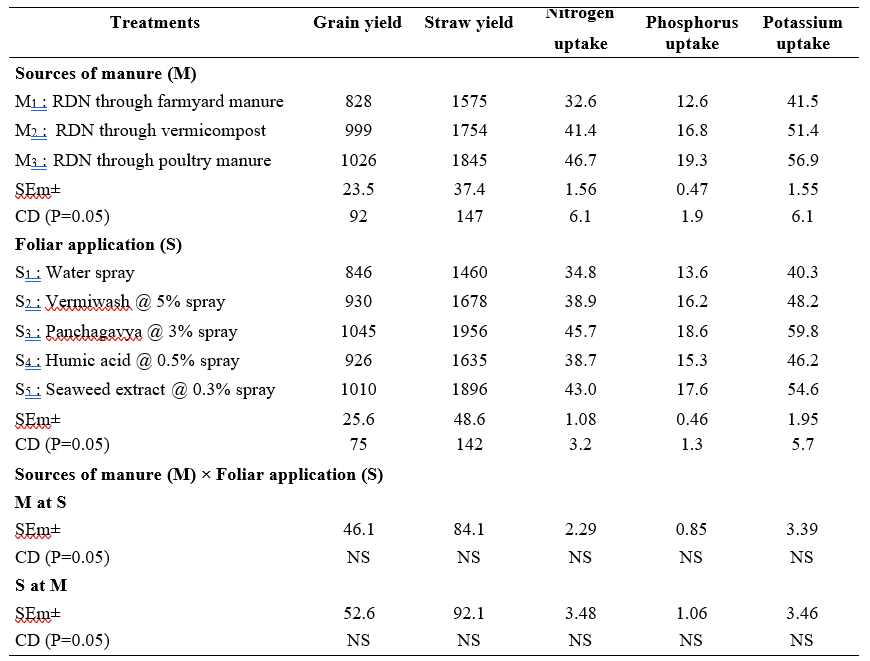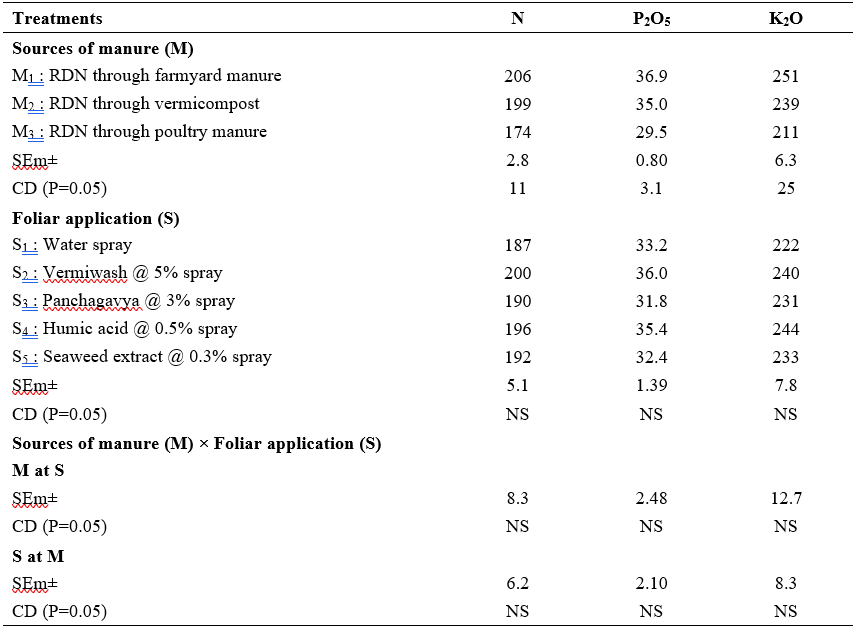Influence of Different Organic Nutrient Sources on Yield, Nutrient Uptake and Soil Fertility Status of Foxtail Millet [Setaria Italica (L.) Beauv.]
0 Views
M. HIMA BINDU*, S. HEMALATHA, N.V. SARALA, B. VAJANTHA AND G. KARUNA SAGAR
Department of Agronomy, S.V. Agricultural College, ANGRAU, Tirupati-517 502..
ABSTRACT
A field experiment was conducted during rabi, 2021-22 on sandy loam soils of dryland farm at S.V. Agricultural College, Tirupati, Acharya N.G. Ranga Agricultural University, Andhra Pradesh in foxtail millet. The experiment was laid out in split-plot design with three main plots and five sub plot treatments replicated thrice. Main plot treatments consisted of three sources of manure viz., Recommended dose of N through farmyard manure (M1), Recommended dose of N through vermicompost (M2) and Recommended dose of N through poultry manure (M3) and sub plot treatments consisted of five foliar applications viz., Water spray (S1), Vermiwash @ 5 % spray (S2), Panchagavya @ 3 % spray (S3), Humic acid @ 0.5 % spray (S4) and Seaweed extract @ 0.3 % spray (S5) allotted to sub-plots. Among the different manures tried, higher yield and nutrient uptake was recorded with the application of recommended dose of nitrogen through poultry manure or vermicompost and higher post-harvest soil nutrient status was recorded with the application of RDN through farmyard manure or vermicompost. Among the foliar application, spraying of 3 % panchagavya or 0.3 % seaweed extract twice at 30 and 45 DAS recorded higher yield and nutrient uptake whereas, post-harvest soil fertility status was not influenced.
KEYWORDS: Proso millet, varieties, nitrogen, yield
INTRODUCTION
Millets are an important source of food and fodder in semi-arid regions and are growing more crucial as the world’s population rises. Each millet has high level of fiber, non-starchy polysaccharides and a few special nutrients. Millets have been dubbed “nutritious grains” due to their higher protein quality and availability of important amino acids. Foxtail millet (Setaria italica L.), one of the eight millets, is a dry land crop of the graminaceae family. The low glycemic index (50.8) of this millet is a very good alternative for diabetic patients. 100 grams of foxtail millet contains 351 calories, 12.3 g of protein, 4.3 g of total fat, 60.9 g of carbohydrate and 8 g of fiber (Vanithasri et al., 2012).
In the recent energy crisis, synthetic fertilizers are becoming exorbitantly expensive and declining soil fertility insist the use of organic manures in crop production (Upendranaik et al., 2018). Mainly in recent days, organic farming is in high demand because of the perceived benefits to the environment as well as human health. A vital component of organic farmingis providing organic sources of nutrients to promote growth as well as to sustain soil quality. Plants should be fed with foliar nutrition as a practical alternative to increase yield. Hence, use of properly designed organic foliar sprays like humic acid extract, seaweed extract, vermiwash and panchagavya are the best ways to correct the micronutrient deficiencies encountered in organic cultivation.
MATERIAL AND METHODS
The experiment was conducted during rabi, 2021- 22 at dryland farm, S. V. Agricultural College, Tirupati campus of Acharya N. G. Ranga Agricultural University which is geographically situated at 13.5° N latitude and 79.5° E longitude at an altitude of 182.9 m above mean sea level in the Southern Agro-climatic Zone of Andhra Pradesh. The present experiment was laid out in a split- plot design and replicated thrice. The treatments included three organic manure levels viz., Recommended dose of N through farmyard manure (M1), Recommended dose of N through vermicompost (M2) and Recommended dose of N through poultry manure (M3) and five foliar applications viz., Water spray (S1), Vermiwash @ 5% spray (S2), Panchagavya @ 3% spray (S3), Humic acid @ 0.5% spray (S4) and Seaweed extract @ 0.3% spray (S5) at 30 and 45 DAS allotted to the sub-plots. The soil of the experimental field was sandy loam, neutral in soil reaction, low in organic carbon (0.35%) and available nitrogen (176.0 kg ha-1), medium in available phosphorus (27 kg ha-1) and available potassium (219 kg ha-1). The crop was sown at 22.5 cm x 10.0 cm spacing with a seed rate of 8 kg ha-1. The variety SiA 3156 of foxtail millet was sown on 22nd of october and recommended dose of the fertilizer 40:20 kg N P2O5 ha-1. All the other recommended practices were also adopted as per the crop requirement.
RESULTS AND DISCUSSION
YIELD
The grain and straw yield were very much influenced by different organic sources. Among the organic manures, higher yield of foxtail millet was recorded with the application of poultry manure (M3), followed by vermicompost (M2), which were at par with each other. The above two treatments were significantly superior to the farmyard manure (M1). Among the foliar applications, higher yield was seen with the application of panchagavya @ 3% (S3) followed by seaweed extract @ 0.3% (S5) which were on par with each other and in turn significantly superior to rest of the treatments. This was followed by vermiwash @ 5% (S2) and humic acid @ 0.5% (S4) and were at par with each other and significantly superior to water spray (S1) which recorded lower yield (Table 1).
During this study, organic manures might have acted as nutrient sources facilitating higher removal by plants. This might have helped in improvement of growth and yield attributes due to higher concentration of macro and micro nutrients in conjunction with steady nutrient release throughout the crop period in poultry manure and also due to the rich source of NPK. Presence of plant growth regulators like auxins, gibberellins and cytokinins in vermicompost might have enhanced the plant growth and overall yield when compared to farmyard manure. The better yield with panchagavya was ascribed due to the higher production of plant growth regulators which have helped in enhancing the biological efficiency of the crop compared to other foliar sprays. Since poultry manure and panchagavya contain high nitrogen and high macro & micro nutrients and growth promoting substances which might have helped in increased yield attributes and yield (Table. 1). These results are in conformity with Sangeetha et al. (2013), Priya and Satyamoorthi (2019) and Raviraja et al. (2020).
NUTRIENT UPTAKE AT HARVEST
During the study, among the manurial treatments the nitrogen and potassium uptake by plant was higher with the application of poultry manure (M3), which was on par with the application of vermicompost (M2) and both the treatments were significantly superior to farmyard manure (M1). With regards to phosphorus uptake by plant, significantly higher values were seen with the application of poultry manure (M3) compared to other treatments. The higher nutrient uptake in poultry manure was due to the fact that it produced more humic acid which form water soluble chelated phosphorus which helped in easy release of phosphorus to the crop. It helped in supplying the nutrients in soluble form for a quite longer period by not allowing the entire soluble form into solution, to come in contact with soil and other inorganic constituents, thereby minimizing fixation and precipitation from the manures, so that the plant roots can very well compete with loss mechanisms and absorb more nutrients as a result of increased cation exchange capacity with increased organic matter content leading to better yield. These findings are in agreement with Sangeetha et al. (2013), Prakash et al. (2018) and Nayak et al. (2020).
Among the foliar sprays higher nutrient uptake was observed with panchagavya @ 3% (S3) closely followed by seaweed extract @ 0.3% (S5) which were significantly superior over other treatments. The next best treatment in obtaining higher nutrient uptake by crop was vermiwash @ 5% (S2) closely followed by humic acid @ 0.5% (S4) which were comparable with each other. Significantly lower values were noticed under water spray (S1). Higher nutrient uptake in panchagavya and seaweed extract was due to the presence of several enzymes and beneficial microorganisms which might have helped in better nutrient uptake, which might have increased the biological efficiency of the crop and thereby creating the better source and sink relationship in the plant that might have contributed for greater absorption and translocation of nutrients. The results corroborate the findings of Raverkar et al. (2016), Ananda et al. (2018) and Mathukiya et al. (2020).
Table 1. Yield and nutrient uptake at harvest (kg ha-1) of foxtail millet as influenced by different sources of manure and foliar application

POST-HARVEST SOIL NUTRIENT STATUS
During the study, higher post-harvest soil available nitrogen, phosphorus and potassium were noticed with the application of farmyard manure (M1), which was comparable with the application of vermicompost (M2) and both were significantly superior to poultry manure (M3). However, available nitrogen, phosphorus and potassium were not influenced by the foliar sprays (Table 2).
The mineralization of organic manures and release pattern of nutrients in to the soil solution differ according to the sources. The enhanced nitrogen status of the soil might be attributed to increased rhizo-microorganisms multiplication through the incorporation of FYM or vermicompost due to the conversion of bound nitrogen into inorganic form. Application of poultry manure also might have enhanced the availability of nitrogen to the crop which may consequently lead to lower status in the soil after harvest as compared to other manures. The results are in conformity with the findings of Banerjee et al. (2013) and Nayak et al. (2020).
Due to decomposition of organic manures, various acids are produced which solubilizes phosphatase and phosphate bearing minerals and lowers the phosphorus fixation and increases the availability and also helps in reducing the K- fixation in soil due to its higher capacity to hold K in available form. The results are in agreement with the findings of Rana et al. (2015).
Table 2. Post-harvest soil available nitrogen (N), phosphorus (P2O5) and potassium (K2O) (kg ha-1) of foxtail millet as influenced by different sources of manure and foliar application

On the basis of experimental study, it was concluded that application of recommended dose of nitrogen through poultry manure or vermicompost and foliar spraying of 3% panchagavya or 0.3% seaweed extract twice at 30 and 45 DAS found better in respect to yield and nutrient uptake of foxtail millet which also help in maintaining soil fertility with the use of organic manures for Southern Agro-climatic Zone of Andhra Pradesh.
LITERATURE CITED
Ananda, M.R., Sharanappa and Murthy, K.N.K. 2018. Impact of organic nutrient management on productivity, nutrient uptake and economics of finger millet in groundnut (Arachis hypogaea L.) – finger millet (Eleusine coracana L.) cropping system. International Journal of Current Microbiology and Applied Sciences. 7(11): 1000-1008.
Banerjee, S., Ghosh, M., Pal, S.K., Mazumdar, D and Mahata, D. 2013. Effect of organic nutrient management practices on yield and economics of scented rice Gobindabhog. Oryza. 50(4): 365-369.
Mathukia, R.K., Chhodavadia, Vekaria, L.C and Vasava, M.S. 2020. Organic cultivation of summer groundnut using cow-based bio-enhancers and botanicals. Legume Research- An International Journal. LR-4431: 1-5.
Nayak, B., Rath, B.S., Shahid, M., Jena, S.N., Nayak,
R.K., Bagchi, T.B., Dash, P.K and Roy, P.S. 2020. Effect of organic nutrient management on productivity, nutrient uptake and nutrient balance sheet in scented rice-rice sequence in a sandy loam soil of Odisha. International Journal of Current Microbiology and Applied Sciences. 9(9): 222-231.
Prakash, P., Sharanappa and Nagaraju. 2018. Effect of different establishment methods and organic nutrient sources on yield, yield attributes and economics of finger millet [Eleusine coracana (L.) Gaertn]. International Journal of Environmental Sciences & Natural Resources. 12(3): 56-60.
Priya, G and Sathyamoorthi, K. 2019. Influence of organic manures on the growth and yield of foxtail millet [Setaria italica (L.) Beauv]. Chemical Science Review and Letters. 8(29): 114-117.
Rana, M., Raverkar, K.P., Pareek, N., Chandra, R and Singh, D.K. 2015. Impact of bio-dynamic preparations and panchagavya in organically managed cropping systems comprising legumes on soil biological health. Legume Research–An International Journal. 38(2): 219-228.
Raverkar, K.P., Pareek, N., Chandra, R., Chauhan, S., Zodape, S.T and Ghosh, A. 2016. Impact of foliar application of seaweed saps on yield, nodulation and nutritional quality in greengram (Vigna radiata L.). Agricultural Research Communication Centre. 39(2): 315-318.
Raviraja., Balanagoudar, S.R., Bhat, S.N., Ravi, M.V and Yadahalli, G.S. 2020. Effect of INM on yield, quality and economics in foxtail millet (Setaria italica L.) in black soil. International Journal of Current Microbiology and Applied Sciences. 9(3): 2109-2116.
Sangeetha, S.P., Balakrishnan, A and Devasenapathy, P. 2013. Influence of organic manures on yield and quality of rice (Oryza sativa L.) and blackgram (Vigna mungo L.) in rice-blackgram cropping sequence. American Journal of Plant Sciences. 4: 1151-1157.
Upendranaik, P., Rao, S., Desai, B.K., Krishnamurthy, D and Yadahalli, V.G. 2018. Effect of different sources of organic manures on growth and yield of foxtail millet (Setaria italica L.) under integrated organic farming system. Advances in Research. 13(2): 1-6.
Vanithasri, J., Kanchana, S., Hemalatha, G., Vanniarajan, C and Sahulhameed, M. 2012. Role of millets and its importance in new mellinium. International Journal of Food Science & Technology. 2(1): 35-47.
- Production Potential of Sweet Corn as Influenced by Organic Manures and Foliar Nutrition
- Characterization of Grain Iron and Zinc Content in Little Millet Genotypes
- Faunistic Studies on Economically Important Lepidopterans in Different Field Crops of Tirupati District
- An Annotated Checklist of Cyperceae, Eriocaulaceae and Potamogetonaceae of Chhattisgarh
- Genetic Divergence Studies for Yield, Yield Components and Resistance to Late Leaf Spot in Groundnut (Arachis Hypogaea L.)
- Effect of Organic Farming on Soil Enzymatic Activity and Productivity of Groundnut Based Cropping System

